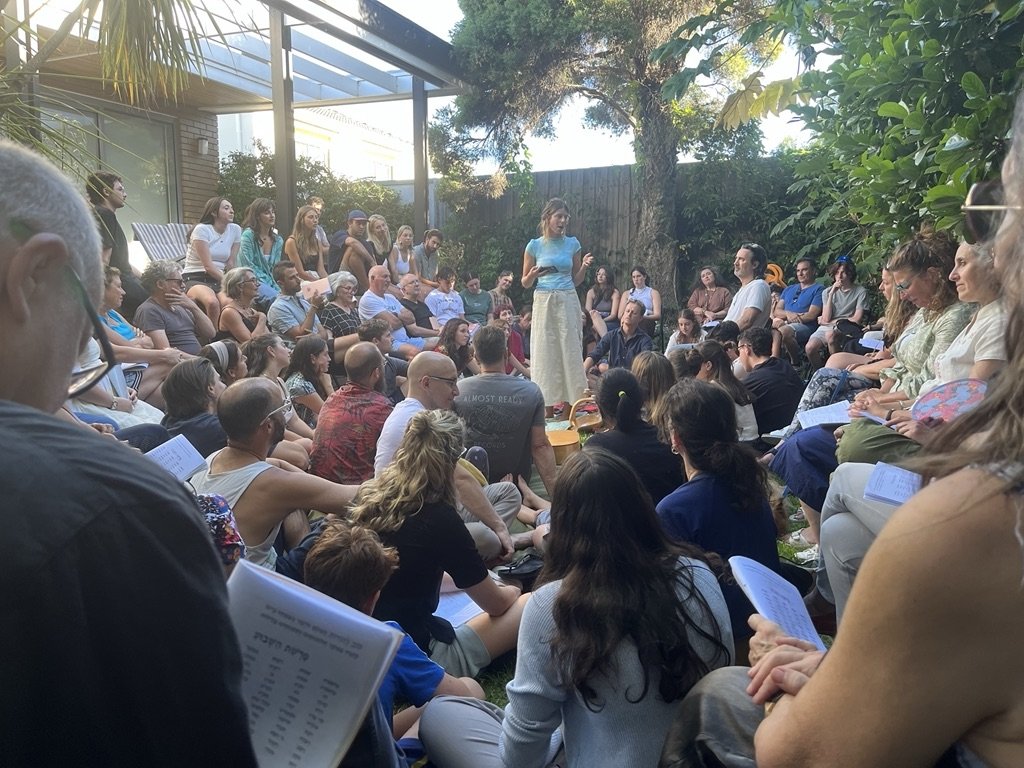Dvar Torah
Welcome and thank you for delivering the Dvar Torah for this week’s Kabbalat Shabbat at Kehilat Kolenu. For more than a millenia Jews around the world have been reading, interpreting and exploring the weekly Parasha. Delivering the Dvar Torah is an incredible opportunity for you to be a part of the largest and oldest book club in the world!
The Hebrew word Dvar means ‘a thing’ or ‘a word’. Dvar Torah literally means ‘a word of the Torah’. At Kehilat Kolenu members of our community are encouraged to participate by giving a short Dvar Torah during Kabbalat Shabbat each week. The purpose is to explore the meaning behind the text and to provide relevant and meaningful explanations and interpretations.
As you will be selecting the text and the interpretation we will also be getting to know something about you. This is what Kolenu is all about: fostering Jewish engagement in our community. We are a learning and connected community and through the Dvar Torah we seek to both learn from you as well as connect with you.
Below is brief guide that will help you create a short, sharp and meaningful Dvar Torah for our community.
First, a few important notes:
Length – please note that the Dvar Torah should be between 4-7 minutes long (aim for 5 and certainly no longer than 7 minutes).
Ideology – please be mindful that Kehilat Kolenu is a secular, humanistic community. In order to ensure the relevance of your Dvar Torah to the ethos of Kolenu and its congregants, please ensure your commentary and message reflect this perspective.
Why do we ask this of you? There are very few avenues for secular humanist Jews in Melbourne to engage with Jewish texts in a relatable framework. As such, we believe that it is crucial that Kolenu continues to provide such a framework for Jews seeking out a relevant, non-theistic connection with our ancient Jewish texts and traditions.
Politics – please be mindful that the Dvar Torah is not a framework for preaching political ideas or advancing political motives. It is an exploration of Jewish literature from which a universal message can be derived.
-
The discovery stage is all about exploring this week’s Parasha’s ins and outs as well as some different commentaries and ideas that have been written about it. We begin by doing some discovery research!
Read the Parasha of the week in full and/or as a short synopsis
Explore commentaries and articles written by some great Jewish thinkers around the world with their take on the Parasha. Below are some useful starting links.
DISCOVERY TIP
There is no need to reinvent the wheel: people have been pondering these writings for thousands of years. Avail yourself of their wisdom. It will give you food for thought and different approaches to the text.
-
From everything that you have read during the discovery phase and using your own personal experiences, come up a few different core messages and ideas that directly relate to the Parasha that you feel is interesting to explore with the community.
Write down 2-3 different ideas/explanations in regards to this week’s Parasha. Make sure that each of them explores just one prominent idea or interpretation.
Ask a few family members or friends which idea or interpretation they find most interesting and would like to hear more about (asking those around you is a simple and direct way of getting early feedback to help you create a more relevant and interesting Dvar Torah)
IDEATION TIPS & OPTIONS
Analyse a small fragment of the text in great detail. You will know that you have picked a good one if other commentators are as interested in it as you are. Observe the text from a distance, taking note of some of its interesting details. This approach is particularly suitable for parashiyot that deal with ritual details at great length.
Begin with an idea from the text and apply it to another issue that is of great interest to you. For example, if the text contains a long list of names, present a history of the origins of some typical Jewish names, perhaps including the names of those present.
Analyse the characters of biblical figures and the events of their lives in ways that will shed some light on our own. For example, the sibling rivalry between Jacob and Esau and the issue of preferred children.
Using the classic form for the D'var Torah, present several apparently discrepant facts and then explain how they are not contradictions at all but instead point to a deeper meaning that is not obvious at first.
Historical insights can illuminate a text in an exciting way.
-
Once you have written down your ideas and have received some feedback on which one resonates, choose the one idea that you feel most excited to write about and that others felt most excited to hear about.
Begin with either/or:
A synopsis of the Parasha
An opening story relevant to your chosen idea, such as a personal story, a current affairs item, a historical observation, a joke or interesting fact
Build your Dvar Torah!
Hone in the specific part of the Parasha you are analysing and describe the text
Present your idea or interpretation
Finish with a single strong core message
Remember it should be 5-7 minutes all up.
BUILD TIP
Don’t be afraid to take risks: It’s can be fun to finds ways relating the Torah Portion to something unexpected. If you think that Moses and Harry Potter have a lot in common, bring that up! Take some creative risks as it could lead to a really interesting Dvar Torah. However, make sure that your creativity doesn’t get in the way of your overall message. It might be a cool connection to compare Moses with Harry Potter, however the real goal is to come up with some lasting insight about Judaism, humanity, or the world.
Tell why this passage, or its interpretations, are meaningful to you. We are an incredible community and would love for you to share more of yourself: your background, your Jewish journey, your life, your thinking, your hopes. What about the passage resonates with you? What about you makes this passage meaningful?
-
Once you have completed your first draft, it’s time to test it.
Read it out aloud to yourself to see how it sounds off the paper. Don’t forget to time it as well in order to ensure it doesn’t exceed the time limit.
Read it out in front of a family member or friend. This is your second opportunity to get feedback. Resist the urge to defend your first draft if you get some critical feedback. Remember this is a great opportunity for you to learn and gain some insights so you can improve it!
-
Hopefully you will have made some realisations or received some feedback from testing it out by yourself and with family or friends. Now go back to the drawing board to make some edits and create your final draft.
FINISHING TIP
Deliver a memorable message: If Kolenu members were sitting around the Shabbat table after Kabbalat Shabbat and a family member asked them what the Dvar Torah this week was about, what would you want them to share? What message would you want them to convey in that moment?
-
Now you should be ready to deliver your Dvar Torah. Some important delivery tips that we’re sure you’re already aware of!
Have your D’var Torah written with you: There is no shame in having your D’var Torah written out in full in front of you and reading it out. There are some great speakers out there who seem to have the ability to reel off a D’var from their heads. However, this is not the reality for most and reading a good D’var can often be more powerful than memorising a poor one!
Make eye contact: Nothing is more important in public speaking than making eye contact with your audience – it will help them relate to you.
Speak up: Sometimes we can have a big crowd with people hiding in the corners. Speak louder than you think is necessary so that everyone can hear your wisdom.
Relax: You got this. You’ve put in the preparation and your congregation supports your strength and authenticity in putting your hand up to deliver. Just take a deep breath and you’ll nail it.

